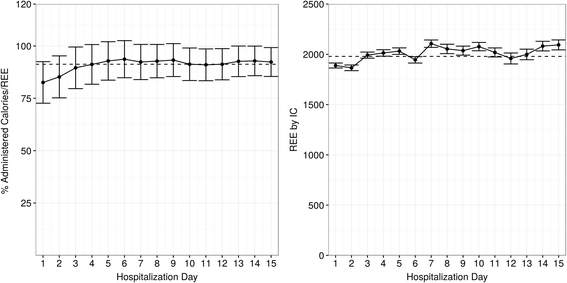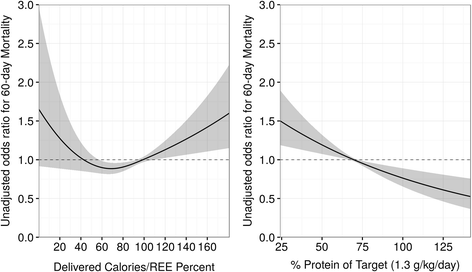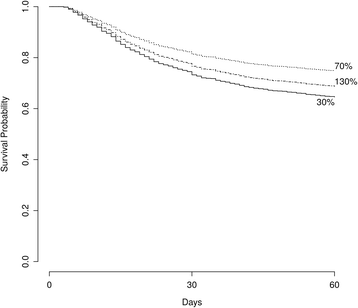Resting energy expenditure, calorie and protein consumption in critically ill patients: a retrospective cohort study
- PMID: 27832823
- PMCID: PMC5105237
- DOI: 10.1186/s13054-016-1538-4
Resting energy expenditure, calorie and protein consumption in critically ill patients: a retrospective cohort study
Abstract
Background: Intense debate exists regarding the optimal energy and protein intake for intensive care unit (ICU) patients. However, most studies use predictive equations, demonstrated to be inaccurate to target energy intake. We sought to examine the outcome of a large cohort of ICU patients in relation to the percent of administered calories divided by resting energy expenditure (% AdCal/REE) obtained by indirect calorimetry (IC) and to protein intake.
Methods: Included patients were hospitalized from 2003 to 2015 at a 16-bed ICU at a university affiliated, tertiary care hospital, and had IC measurement to assess caloric targets. Data were drawn from a computerized system and included the % AdCal/REE and protein intake and other variables. A Cox proportional hazards model for 60-day mortality was used, with the % AdCal/REE modeled to accommodate non-linearity. Length of stay (LOS) and length of ventilation (LOV) were also assessed.
Results: A total of 1171 patients were included. The % AdCal/REE had a significant non-linear (p < 0.01) association with mortality after adjusting for other variables (p < 0.01). Increasing the percentage from zero to 70 % resulted in a hazard ratio (HR) of 0.98 (CI 0.97-0.99) pointing to reduced mortality, while increases above 70 % suggested an increase in mortality with a HR of 1.01 (CI 1.01-1.02). Increasing protein intake was also associated with decreased mortality (HR 0.99, CI 0.98-0.99, p = 0.02). An AdCal/REE >70 % was associated with an increased LOS and LOV.
Conclusions: The findings of this study suggest that both underfeeding and overfeeding appear to be harmful to critically ill patients, such that achieving an Adcal/REE of 70 % had a survival advantage. A higher caloric intake may also be associated with harm in the form of increased LOS and LOV. The optimal way to define caloric goals therefore requires an exact estimate, which is ideally performed using indirect calorimetry. These findings may provide a basis for future randomized controlled trials comparing specific nutritional regimens based on indirect calorimetry measurements.
Keywords: Calorie consumption; Indirect calorimetry; Nutrition; Protein; Resting energy expenditure.
Figures



Comment in
-
Optimal energy delivery and measured energy expenditure-impact of length of stay.Crit Care. 2017 Feb 22;21(1):39. doi: 10.1186/s13054-017-1612-6. Crit Care. 2017. PMID: 28222803 Free PMC article. No abstract available.
-
Resting energy expenditure and optimal nutrition in critical care: how to guide our calorie prescriptions.Crit Care. 2017 Jun 5;21(1):128. doi: 10.1186/s13054-017-1717-y. Crit Care. 2017. PMID: 28583147 Free PMC article. No abstract available.
References
-
- Alberda C, Gramlich L, Jones N, Jeejeebhoy K, Day AG, Dhaliwal R, et al. The relationship between nutritional intake and clinical outcomes in critically ill patients: results of an international multicenter observational study. Intensive Care Med. 2009;35:1728–37. doi: 10.1007/s00134-009-1567-4. - DOI - PubMed
-
- National Heart, Lung, and Blood Institute Acute Respiratory Distress Syndrome (ARDS) Clinical Trials Network. Rice TW, Wheeler AP, Thompson BT, Steingrub J, Hite RD, et al. Initial trophic vs full enteral feeding in patients with acute lung injury: the EDEN randomized trial. JAMA. 2012;307:795–803. doi: 10.1001/jama.2012.137. - DOI - PMC - PubMed
Publication types
MeSH terms
Substances
LinkOut - more resources
Full Text Sources
Other Literature Sources
Medical

